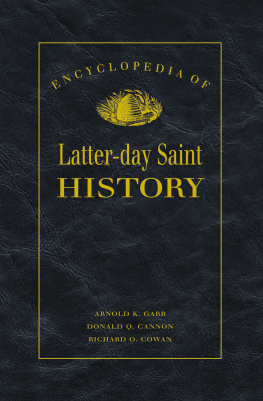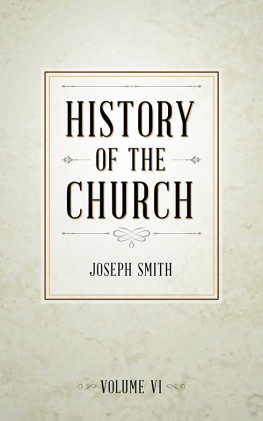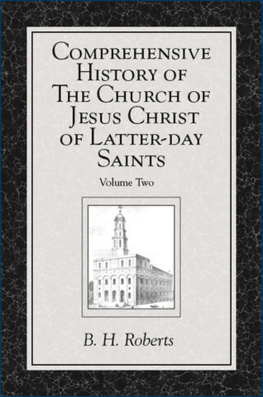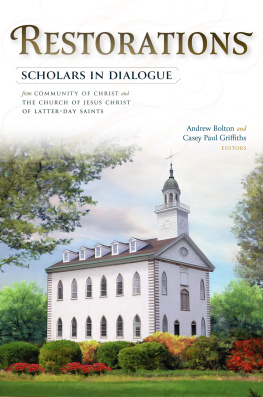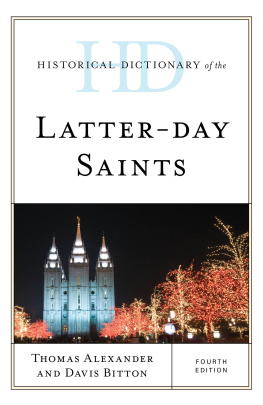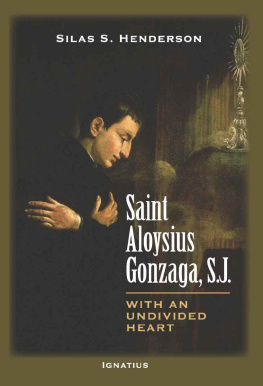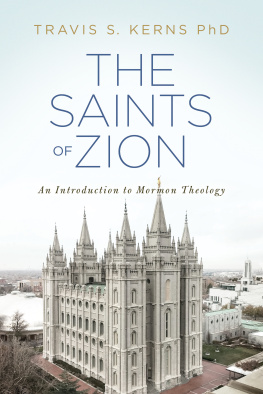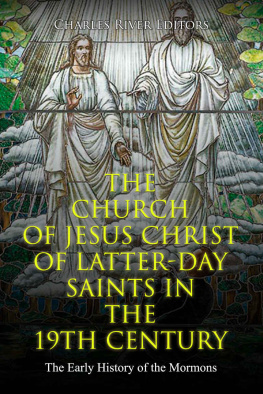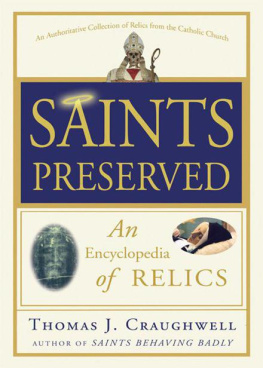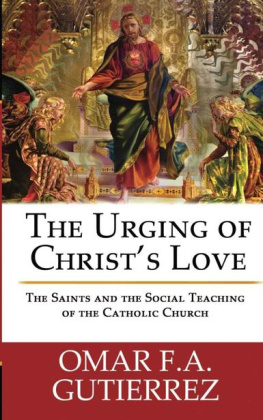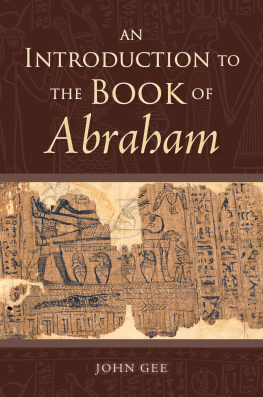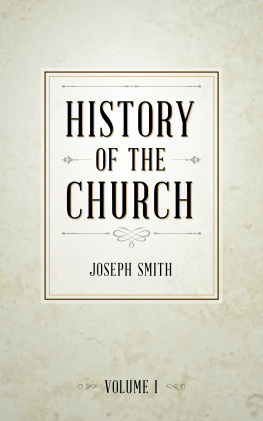Donald Q. Cannon - Encyclopedia of Latter-day Saint History
Here you can read online Donald Q. Cannon - Encyclopedia of Latter-day Saint History full text of the book (entire story) in english for free. Download pdf and epub, get meaning, cover and reviews about this ebook. year: 2000, publisher: Deseret Book Company, genre: Religion. Description of the work, (preface) as well as reviews are available. Best literature library LitArk.com created for fans of good reading and offers a wide selection of genres:
Romance novel
Science fiction
Adventure
Detective
Science
History
Home and family
Prose
Art
Politics
Computer
Non-fiction
Religion
Business
Children
Humor
Choose a favorite category and find really read worthwhile books. Enjoy immersion in the world of imagination, feel the emotions of the characters or learn something new for yourself, make an fascinating discovery.
- Book:Encyclopedia of Latter-day Saint History
- Author:
- Publisher:Deseret Book Company
- Genre:
- Year:2000
- Rating:5 / 5
- Favourites:Add to favourites
- Your mark:
- 100
- 1
- 2
- 3
- 4
- 5
Encyclopedia of Latter-day Saint History: summary, description and annotation
We offer to read an annotation, description, summary or preface (depends on what the author of the book "Encyclopedia of Latter-day Saint History" wrote himself). If you haven't found the necessary information about the book — write in the comments, we will try to find it.
A collection of historical information of the Church of Jesus Christ of Latter-day Saints.
Encyclopedia of Latter-day Saint History — read online for free the complete book (whole text) full work
Below is the text of the book, divided by pages. System saving the place of the last page read, allows you to conveniently read the book "Encyclopedia of Latter-day Saint History" online for free, without having to search again every time where you left off. Put a bookmark, and you can go to the page where you finished reading at any time.
Font size:
Interval:
Bookmark:


All rights reserved. No part of this book may be reproduced in any form or by any means without permission in writing from the publisher, Deseret Book Company, P.O. Box 30178, Salt Lake City Utah 30178. This work is not an official publication of The Church of Jesus Christ of Latter-day Saints. The views expressed herein are the responsibility of the author and do not necessarily represent the position of the Church or of Deseret Book. Deseret Book is a registered trademark of Deseret Book Company.
PREFACE
As teachers of history of The Church of Jesus Christ of Latter-day Saints, we have recognized the need for a convenient, one-volume reference work. Our objective has been to present accurate, concise, and readable articles on a wide variety of Church history topics. These range from items dealing with the Restoration and its early days to articles on current topics. In all, this encyclopedia contains more than 1,400 entries.
More than 350 authors have contributed to this work. Of them, about 50 are colleagues in Religious Education at Brigham Young University and an additional 50 come from other colleges and departments within Brigham Young University. Our authors live in 26 states and approximately 20 nations. In many cases, these authors are the recognized authorities on the topics they treat.
Entries in the encyclopedia discuss a variety of topics. Some describe places that are the sites of specific events, while others present the Church's history in all 50 states, all Canadian provinces, and more than 200 other countries, territories, and political entities. More than 450 entries are biographies, including essays on all who have served in the First Presidency and the Quorum of the Twelve Apostles, other selected general authorities, and many local pioneers in the international Church. Other entries treat key events-both in and out of the Church-that have affected the direction of Latter-day Saint history. Still other entries discuss organizations, issues, and other themes.
A typical entry begins with a topic sentence that identifies in a few words the significance of the subject being treated. The body of the article then presents a succinct discussion. A list of sources includes places where you can turn for additional information on the subject.
The encyclopedia includes numerous cross-references to help you find the information you are seeking. Words in bold type indicate a cross-reference to another article. To conserve space, we often use the phrase "the Church" in referring to The Church of Jesus Christ of Latter-day Saints.
We have tried diligently to provide the most accurate information, but sometimes sources present conflicting data or no information at all. In some instances we chose to include only the information we felt was most reliable; in a few other cases we listed alternative dates when conflicting sources appeared to be equally credible.
We acknowledge assistance given by many others. We are grateful for the contributions from our numerous authors and for the assistance of those who have reviewed portions of our text. We express our thanks particularly to Lisa Kurki and Richard D. McClellan, who as student editors made refinements in form and style and checked sources for accuracy. We also appreciate Matthew Green, Bryan Rasmussen, Sarah Barnham, Leah Call, Rebecca Jackson, Matthew Willden, Sydney Hughes, Rachel Wilkins, and Michele Daetwyler, who have helped us shepherd the entries through the various stages of manuscript preparation. We are grateful to Religious Education at BYU for providing funds to make this help available. We particularly appreciate the support and encouragement given by Dean Robert L. Millet and our department chairs, Raymond S. Wright and Paul H. Peterson. We are also grateful for the support our families gave us during the many hours we were away from them while working on this project. Finally, we express our thanks to the people at Deseret Book who gave appreciated refinement to our manuscript and prepared this work for publication: Deseret Book imprint director Cory Maxwell; senior editor Suzanne Brady and her editorial colleagues; art director Richard Erickson; and typographer Laurie Cook.
It is our conviction that The Church of Jesus Christ of Latter-day Saints is God's restored kingdom on earth, that it has a divine destiny, and that it is led by inspiration. We have sought to be fair, scholarly, and responsible in our treatment of the subjects we have included in this book. We hope not only that you will find the facts you are seeking but also that you will gain a greater appreciation for the accomplishments of the Church and its people.
A
ABRAHAM, BOOK OF.
See BOOK OF ABRAHAM
AARONIC PRIESTHOOD.
The Aaronic Priesthood, a lesser priesthood or "appendage" to the Melchizedek Priesthood, was restored 15 May 1829 by John the Baptist to Joseph Smith and Oliver Cowdery. This priesthood provides authority to baptize and carry out other responsibilities. Early revelations (D&C 20; 84; 107) identify four Aaronic Priesthood officesdeacon, teacher, priest and bishopand the duties of each. Priests are to preach, teach, expound, exhort, baptize, and administer the sacrament; visit members in their homes and teach them to pray and fulfill family duties; conduct meetings and ordain priests, teachers and deacons. Teachers are to watch over Church members: prevent iniquity, lying, backbiting, and evil speaking; see that members attend meetings and do their duties; conduct meetings; and expound, exhort, teach, and invite souls to come unto Christ. Deacons are to assist teachers in their duties as occasion requires. Each office is to have a quorum (a deacons quorum has 12 deacons; teachers, 24; and priests, 48) and a quorum presidency. A bishop is president of the Aaronic Priesthood in his ward. Through most of the nineteenth century, male adults filled the Aaronic Priesthood offices, assisted by a few youths. Latter-day Saint Aaronic Priesthood history has passed through four distinct periods:
1. Before the endowment was received and before wards were organized (1829-1845). Aaronic Priesthood bearers were adults (except for a few outstanding youths). Their primary duty was to visit members in their homes. Their quorums were stake quorums.
2. Acting priesthood bearers with stake quorums (1846-1877). After the temple endowment was broadly introduced in 1845, men called on missions or marrying for eternity had to receive their endowments, a prerequisite for which was Melchizedek Priesthood ordination. That left few adult males to serve in Aaronic Priesthood offices. To fill the ranks, Melchizedek Priesthood bearers were called to serve as acting priests, teachers, and deacons. Some boys received priesthood ordinations. Deacon, teacher, and priest quorums were stake units. In Utah, wards became the main local units and ward bishops the primary local officer, aided by a corps of acting teachers and priests called block or ward teachers. Deacons served as ward meetinghouse custodians.
3. Acting and ordained priesthood bearers with ward quorums (1877-1908). In 1877 the First Presidency instructed that every worthy young man receive priesthood ordination. Soon boys from ages 11 to 18 received the priesthood; most became deacons and stayed such until becoming elders. Few boys blessed or passed the sacrament or did what is now called home teaching.
Font size:
Interval:
Bookmark:
Similar books «Encyclopedia of Latter-day Saint History»
Look at similar books to Encyclopedia of Latter-day Saint History. We have selected literature similar in name and meaning in the hope of providing readers with more options to find new, interesting, not yet read works.
Discussion, reviews of the book Encyclopedia of Latter-day Saint History and just readers' own opinions. Leave your comments, write what you think about the work, its meaning or the main characters. Specify what exactly you liked and what you didn't like, and why you think so.

